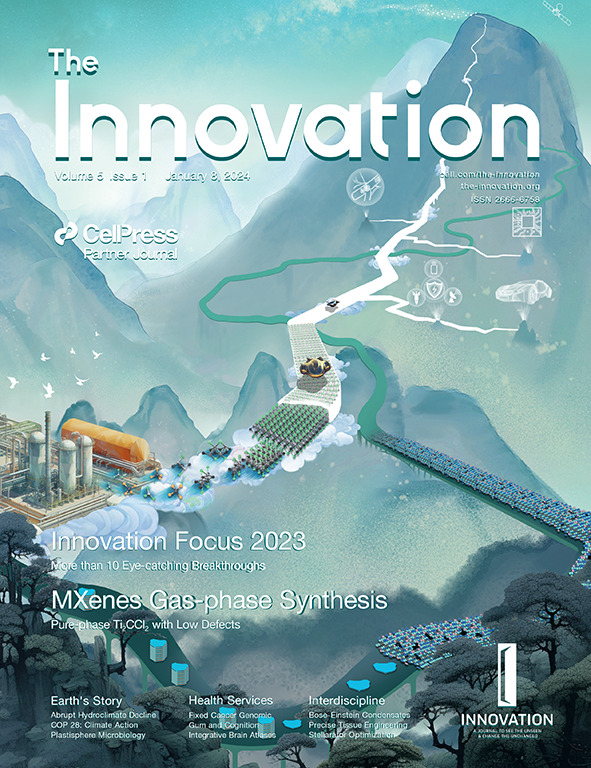基于泛组学的疫情真菌物种复合体高度多药适应菌株的特征描述与预测
IF 33.2
1区 综合性期刊
Q1 MULTIDISCIPLINARY SCIENCES
引用次数: 0
摘要
来自该物种复合体(CGSC)的菌株导致了西北太平洋隐球菌病的爆发,这是迄今为止已知的在原本健康的人类宿主中发生的最大的威胁生命的真菌感染集群。在这项研究中,我们采用了一种基于泛表型的方法,评估了 CGSC 菌株在 31 种压力条件下的适应性结果,全面概述了这一致病支系中 2,821 种表型-菌株关联。表型聚类分析显示,在一部分 CGSC 菌株中,不同类型的胁迫表型之间存在很强的相关性,这表明它们对各种胁迫的适应是由共同的决定因素协调的。值得注意的是,包括疫情分离株在内的一组特定菌株对治疗隐球菌病最常用的三种抗真菌药物(两性霉素 B、5-氟胞嘧啶和氟康唑)都表现出了显著的适应能力。通过整合泛基因组学和泛转录组学分析,我们发现了以前未曾认识到的基因,这些基因在一株具有高度多药适应性的爆发菌株中赋予其多药耐药性方面发挥着关键作用。从这些基因中,我们发现了能够准确预测高多药适应性 CGSC 株系的生物标记物,利用机器学习算法,其最大准确率和曲线下面积(AUC)分别达到了 0.79 和 0.86。总之,我们开发了一种泛原子方法来鉴定隐球菌的多药耐药性决定因素,并预测可能引起重大临床问题的高度多药适应的CGSC菌株。本文章由计算机程序翻译,如有差异,请以英文原文为准。
Pan-omics-based characterization and prediction of highly multidrug-adapted strains from an outbreak fungal species complex
Strains from the species complex (CGSC) have caused the Pacific Northwest cryptococcosis outbreak, the largest cluster of life-threatening fungal infections in otherwise healthy human hosts known to date. In this study, we utilized a pan-phenome-based method to assess the fitness outcomes of CGSC strains under 31 stress conditions, providing a comprehensive overview of 2,821 phenotype-strain associations within this pathogenic clade. Phenotypic clustering analysis revealed a strong correlation between distinct types of stress phenotypes in a subset of CGSC strains, suggesting that shared determinants coordinate their adaptations to various stresses. Notably, a specific group of strains, including the outbreak isolates, exhibited a remarkable ability to adapt to all three of the most commonly used antifungal drugs for treating cryptococcosis (amphotericin B, 5-fluorocytosine, and fluconazole). By integrating pan-genomic and pan-transcriptomic analyses, we identified previously unrecognized genes that play crucial roles in conferring multidrug resistance in an outbreak strain with high multidrug adaptation. From these genes, we identified biomarkers that enable the accurate prediction of highly multidrug-adapted CGSC strains, achieving maximum accuracy and area under the curve (AUC) of 0.79 and 0.86, respectively, using machine learning algorithms. Overall, we developed a pan-omic approach to identify cryptococcal multidrug resistance determinants and predict highly multidrug-adapted CGSC strains that may pose significant clinical concern.
求助全文
通过发布文献求助,成功后即可免费获取论文全文。
去求助
来源期刊

The Innovation
MULTIDISCIPLINARY SCIENCES-
CiteScore
38.30
自引率
1.20%
发文量
134
审稿时长
6 weeks
期刊介绍:
The Innovation is an interdisciplinary journal that aims to promote scientific application. It publishes cutting-edge research and high-quality reviews in various scientific disciplines, including physics, chemistry, materials, nanotechnology, biology, translational medicine, geoscience, and engineering. The journal adheres to the peer review and publishing standards of Cell Press journals.
The Innovation is committed to serving scientists and the public. It aims to publish significant advances promptly and provides a transparent exchange platform. The journal also strives to efficiently promote the translation from scientific discovery to technological achievements and rapidly disseminate scientific findings worldwide.
Indexed in the following databases, The Innovation has visibility in Scopus, Directory of Open Access Journals (DOAJ), Web of Science, Emerging Sources Citation Index (ESCI), PubMed Central, Compendex (previously Ei index), INSPEC, and CABI A&I.
 求助内容:
求助内容: 应助结果提醒方式:
应助结果提醒方式:


